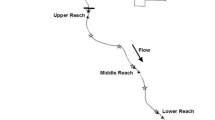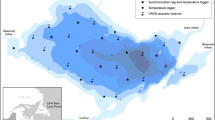Abstract
Drift-feeding salmonids in boreal streams face temperatures below physical optima for extensive periods of the year. Because juvenile salmonids react to low water temperatures by becoming nocturnal, knowledge about their foraging ability at low light intensities in cold water is needed to accurately estimate energy intake during non-summer conditions. In a laboratory stream channel, we studied temperature effects on the drift-feeding behaviour of juvenile Atlantic salmon, brown trout, and European grayling in simulated daylight and moonlight at temperatures ranging from 2 °C to 11 °C. Prey capture probability was positively related to temperature, but the temperature dependence did not agree with predictions of the Metabolic Theory of Ecology. Furthermore, reaction distance was positively related to temperature for the three species, which may be one of the underlying mechanisms responsible for the temperature effects on prey capture probability. Overall, the three species had similar capture rates at the different temperature and light levels, although there were species differences. European grayling had a slightly higher prey capture probability than brown trout, and brown trout had a shorter reaction distance than Atlantic salmon and European grayling. These results have implications for both energetics-based drift-foraging theory and for studies of winter ecology.


Similar content being viewed by others
References
Ali MA (1961) Histophysiological studies on juvenile Atlantic salmon (Salmo salar) retina. Can J Zool 39:511–525. doi:10.1139/z61-055
Allen AP, Gillooly JF (2007) The mechanistic basis of the metabolic theory of ecology. Oikos 116:1073–1077. doi:10.1111/j.0030-1299.2007.16079.x
Allen DM, Loew ER, McFarland WN (1982) Seasonal change in the amount of visual pigment in the retinae of fish. Can J Zool 60:281–287. doi:10.1139/z82-037
Allen DM, McFarland WN, Munz FW, Poston HA (1973) Changes in the visual pigments of trout. Can J Zool 51:901–914. doi:10.1139/z73-137
Amundsen PA, Gabler HM, Herfindal T, Riise LS (2000) Feeding chronology of Atlantic salmon parr in subarctic rivers: consistency of nocturnal feeding. J Fish Biol 56:676–686. doi:10.1006/jfbi.1999.1187
Brown JH, Gillooly JF, Allen AP, Savage VM, West GB (2004) Toward a metabolic theory of ecology. Ecology 85:1771–1789. doi:10.1890/03-9000
Clarke A (2004) Is there a universal temperature dependence of metabolism? Funct Ecol 18:252–256. doi:10.1111/j.0269-8463.2004.00842.x
Confer JL, Howick GL, Corzette MH, Kramer SL, Fitzgibbon S, Landesberg R (1978) Visual predation by plaktivores. Oikos 31:27–37. doi:10.2307/3543380
DeVries MS, Wainwright PC (2006) The effects of acute temperature change on prey capture kinematics in largemouth bass, Micropterus salmoides. Copeia 2006:437–444. doi:10.1643/0045-8511(2006)2006[437:TEOATC]2.0.CO;2
Elliott JM (2002) Shadow competition in wild juvenile sea-trout. J Fish Biol 61:1268–1281. doi:10.1111/j.1095-8649.2002.tb02470.x
Elliott JM, Hurley MA (1997) A functional model for maximum growth of Atlantic Salmon parr, Salmo salar, from two populations in northwest England. Funct Ecol 11:592–603. doi:10.1046/j.1365-2435.1997.00130.x
Elliott JM, Hurley MA (1998) A new functional model for estimating the maximum amount of invertebrate food consumed per day by brown trout, Salmo trutta. Freshwater Biol 39:339–349. doi:10.1046/j.1365-2427.1998.00288.x
Englund G, Öhlund G, Hein CL, Diehl S (2011) Temperature dependence of the functional response. Ecol Lett 14:914–921. doi:10.1111/j.1461-0248.2011.01661.x
Fraser NHC, Metcalfe NB (1997) The costs of becoming nocturnal: feeding efficiency in relation to light intensity in juvenile Atlantic salmon. Funct Ecol 11:385–391. doi:10.1046/j.1365-2435.1997.00098.x
Fraser NHC, Metcalfe NB, Thorpe JE (1993) Temperature-dependent switch between diurnal and nocturnal foraging in salmon. P Roy Soc Lond B Bio 252:135–139
Gillooly JF, Brown JH, West GB, Savage VM, Charnov EL (2001) Effects of size and temperature on metabolic rate. Science 293:2248–2251. doi:10.1126/science.1061967
Graham WD, Thorpe JE, Metcalfe NB (1996) Seasonal current holding performance of juvenile Atlantic salmon in relation to temperature and smolting. Can J Fish Aquat Sci 53:80–86. doi:10.1139/f95-167
Hartman GF (1965) The role of behavior in the ecology and interaction of underyearling coho salmon (Oncorhynchus kisutch) and steelhead trout (Salmo gairdneri). J Fish Res Board Can 22:1035–1081. doi:10.1139/f65-095
Harwood AJ, Metcalfe NB, Armstrong JD, Griffiths SW (2001) Spatial and temporal effects of interspecific competition between Atlantic salmon (Salmo salar) and brown trout (Salmo trutta) in winter. Can J Fish Aquat Sci 58:1133–1140. doi:10.1139/f01-061
Harwood AJ, Metcalfe NB, Griffiths SW, Armstrong JD (2002) Intra- and inter-specific competition for winter concealment habitat in juvenile salmonids. Can J Fish Aquat Sci 59:1515–1523. doi:10.1139/f02-119
Heggenes J, Dokk JG (2001) Contrasting temperatures, waterflows, and light: seasonal habitat selection by young Atlantic salmon and brown trout in a boreonemoral river. Regul Rivers 17:623–635. doi:10.1002/rrr.620
Heggenes J, Krog OMW, Lindas OR, Dokk JG, Bremnes T (1993) Homeostatic behavioral responses in a changing environment - brown trout (Salmo trutta) become nocturnal during winter. J Anim Ecol 62:295–308
Henderson MA, Northcote TG (1985) Visual prey detection and foraging in sympatric cutthroat trout (Salmo clarki clarki) and Dolly Varden (Salvelinus malma). Can J Fish Aquat Sci 42:785–790. doi:10.1139/f85-100
Hill J, Grossman GD (1993) An energetic model of microhabitat use for rainbow trout and rosyside dace. Ecology 74:685–698
Huusko A et al (2007) Life in the ice lane: the winter ecology of stream salmonids. River Res Appl 23:469–491. doi:10.1002/rra.999
Johansen M et al (2010) Prey availability and juvenile Atlantic salmon feeding during winter in a regulated subarctic river subject to loss of ice cover. Hydrobiologia 644:217–229. doi:10.1007/s10750-010-0118-x
Kalleberg H (1958) Observations in a stream tank of territoriality and competition in juvenile salmon and trout (Salmo salar L., and Salmo trutta L.). Inst Fresh Res Drott Rep 39:55–98
Mallet JP, Charles S, Persat H, Auger P (1999) Growth modelling in accordance with daily water temperature in European grayling (Thymallus thymallus L.). Can J Fish Aquat Sci 56:994–1000. doi:10.1139/f99-031
Mazur MM, Beauchamp DA (2003) A comparison of visual prey detection among species of piscivorous salmonids: effects of light and low turbidities. Environ Biol Fish 67:397–405. doi:10.1023/a:1025807711512
Metcalfe NB, Fraser NHC, Burns MD (1999) Food availability and the nocturnal vs. diurnal foraging trade-off in juvenile salmon. J Anim Ecol 68:371–381
Metcalfe NB, Valdimarsson SK, Fraser NHC (1997) Habitat profitability and choice in a sit-and-wait predator: juvenile salmon prefer slower currents on darker nights. J Anim Ecol 66:866–875
O’Connor MP et al (2007) Reconsidering the mechanistic basis of the metabolic theory of ecology. Oikos 116:1058–1072. doi:10.1111/j.0030-1299.2007.15534.x
Orpwood JE, Griffiths SW, Armstrong JD (2006) Effects of food availability on temporal activity patterns and growth of Atlantic salmon. J Anim Ecol 75:677–685. doi:10.1111/j.1365-2656.2006.01088.x
Piccolo JJ, Hughes HF, Bryant MD (2007) The effects of water depth on prey detection and capture by juvenile coho salmon and steelhead. Ecol Freshw Fish 16:432–441. doi:10.1111/j.1600-0633.2007.00242.x
Piccolo JJ, Hughes NF, Bryant MD (2008) Water velocity influences prey detection and capture by drift-feeding juvenile coho salmon (Oncorhynchus kisutch) and steelhead (Oncorhynchus mykiss irideus). Can J Fish Aquat Sci 65:266–275. doi:10.1139/f07-172
Rader RB, Belish T, Young MK, Rothlisberger J (2007) The scotopic visual sensitivity of four species of trout: a comparative study. W N Am Nat 67:524–537. doi:10.3398/1527-0904(2007)67[524:tsvsof]2.0.co;2
Railsback SF, Harvey BC (2011) Importance of fish behaviour in modelling conservation problems: food limitation as an example. J Fish Biol 79:1648–1662. doi:10.1111/j.1095-8649.2011.03050.x
Railsback SF, Harvey BC, Hayse JW, LaGory KE (2005) Tests of theory for diel variation in salmonid feeding activity and habitat use. Ecology 86:947–959. doi:10.1890/04-1178
Rall BC, Brose U, Hartvig M, Kalinkat G, Schwarzmüller F, Vucic-Pestic O, Petchey OL (2012) Universal temperature and body-mass scaling of feeding rates. Philos T Roy Soc B 367:2923–2934. doi:10.1098/rstb.2012.0242
Riley WD, Ives MJ, Pawson MG, Maxwell DL (2006) Seasonal variation in habitat use by salmon, Salmo salar, trout, Salmo trutta and grayling, Thymallus thymallus, in a chalk stream. Fisheries Manag Ecol 13:221–236. doi:10.1111/j.1365-2400.2006.00496.x
Ringler NH (1985) Individual and temporal variation in prey switching by brown trout, Salmo trutta. Copeia 4:918–926
Robinson FW, Tash JC (1979) Feeding by Arizona trout (Salmo apache) and brown trout (Salmo trutta) at different light intensities. Environ Biol Fish 4:363–368. doi:10.1007/bf00005525
Savage VM, Gillooly JF, Brown JH, West GB, Charnov EL (2004) Effects of body size and temperature on population growth. Am Nat 163:429–441
Schmidt D, O’Brien WJ (1982) Planktivorous feeding ecology of Arctic grayling (Thymallus arcticus). Can J Fish Aquat Sci 39:475–482
Tunney TD, Steingrímsson SÓ (2012) Foraging mode variation in three stream-dwelling salmonid fishes. Ecol Freshw Fish 21:570–580. doi:10.1111/j.1600-0633.2012.00577.x
Vehanen T, Huusko A (2002) Behaviour and habitat use of young-of-the-year Atlantic salmon (Salmo salar) at the onset of winter in artificial streams. Arch Hydrobiol 154:133–150
Vogel JL, Beauchamp DA (1999) Effects of light, prey size, and turbidity on reaction distances of lake trout (Salvelinus namaycush) to salmonid prey. Can J Fish Aquat Sci 56:1293–1297. doi:10.1139/f99-071
Watz J, Piccolo JJ (2011) The role of temperature in the prey capture probability of drift-feeding juvenile brown trout (Salmo trutta). Ecol Freshw Fish 20:393–399. doi:10.1111/j.1600-0633.2010.00470.x
Watz J, Piccolo JJ, Greenberg L, Bergman E (2012) Temperature-dependent prey capture efficiency and foraging modes of brown trout Salmo trutta. J Fish Biol 81:345–350. doi:10.1111/j.1095-8649.2012.03329.x
Webb PW (1978) Temperature effects on acceleration of rainbow trout (Salmo gairdneri). J Fish Res Board Can 35:1417–1422
Wintzer AP, Motta PJ (2004) The effects ofbtemperature on prey capture kinematics of bluegill (Lepomis macrochirus): implications for feeding studies. Can J Zool 82:794–799. doi:10.1139/z04-061
Zamor RM, Grossman GD (2007) Turbidity affects foraging success of drift-feeding rosyside dace. T Am Fish Soc 136:167–176. doi:10.1577/t05-316
Acknowledgments
Funding was provided by the Department of Environmental and Life Sciences, Karlstad University. The study was approved by the Animal Ethical Board of Sweden (reference 341–2009).
Author information
Authors and Affiliations
Corresponding author
Rights and permissions
About this article
Cite this article
Watz, J., Piccolo, J., Bergman, E. et al. Day and night drift-feeding by juvenile salmonids at low water temperatures. Environ Biol Fish 97, 505–513 (2014). https://doi.org/10.1007/s10641-013-0190-y
Received:
Accepted:
Published:
Issue Date:
DOI: https://doi.org/10.1007/s10641-013-0190-y




